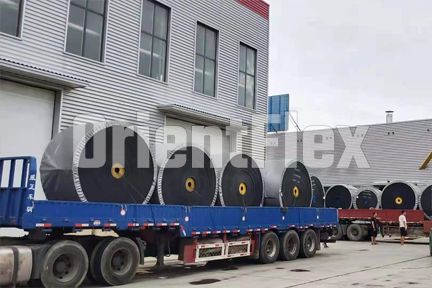- Email orientflex@orientrubber.com
- WhatsApp / Phone+86 180 3186 9514
Optional conveyor belt:
1. Accurately state the name and nature of specific materials. Especially the particle size, temperature, whether it has acid, alkali and other corrosive properties and special requirements. For example, the use temperature of the heat-resistant conveyor belt should be stated.
2. Indicate the specific application occasions and the required specifications (width, length, number of layers, thickness, etc.), especially the temperature and transportation capacity of the heat-resistant conveyor belt.
Storage:
1. Conveyor belts should be kept clean during transportation and storage, avoid direct sunlight or rain and snow, prevent contact with acids, alkalis, oils, organic solvents and other substances, and be one meter away from heating devices.
2. When the conveyor belt is stored, the warehouse temperature should be kept between 18-40 ℃, and the relative humidity should be kept between 50-80%.
3. During the storage period of the conveyor belt, the products must be placed in rolls without being folded, and the conveyor belt should be turned over every season.
How to use the conveyor belt:
1. Prevent the conveyor belt from starting under load.
2. If the conveyor belt deviates, measures should be taken to correct it in time.
3. Conveyor belts of different types and specifications are not suitable to be connected together, and the joints should preferably be glued.
4. The type, structure, specification and number of layers of the conveyor belt should be selected reasonably according to the conditions of use.
5. The operating speed of the conveyor belt should generally not be greater than 2.5m/s, and the material with large lumpiness and abrasiveness and the unloading device using fixed pears should be as low as possible.
6. The relationship between the diameter of the drive roller of the roller conveyor and the cloth layer of the conveyor belt, the matching of the drive roller and the reversing roller, and the requirements for the roller groove angle should be selected reasonably according to the design requirements of the conveyor.
7. The feeding direction should follow the running direction of the conveyor belt. In order to reduce the impact of the material on the conveyor belt when the material falls, a chute should be used to reduce the material drop distance; the conveyor belt receiving section should shorten the distance between the rollers and adopt buffer rollers In order to leak materials, the conveyor belt should adopt a soft and moderate baffle plate to prevent the baffle plate from being too hard and scratching the belt surface of the conveyor belt.
8. When the conveyor is in use, if any idler rollers are missing, they should be added and repaired in time; the idler rollers are covered by materials, causing ineffective rotation, preventing leakage of materials from being stuck between the roller and the belt, pay attention to the lubrication of the movable part of the conveyor belt, But the conveyor belt must not be oily.
9. Avoid the conveyor belt from being blocked by the frame, pillars or block materials, and prevent it from breaking and tearing. When the conveyor belt is found to be partially damaged, use artificial cotton to repair it in time to avoid expansion.
You can contact or visit us in our office from Monday to Friday from 8:00 - 18:00





